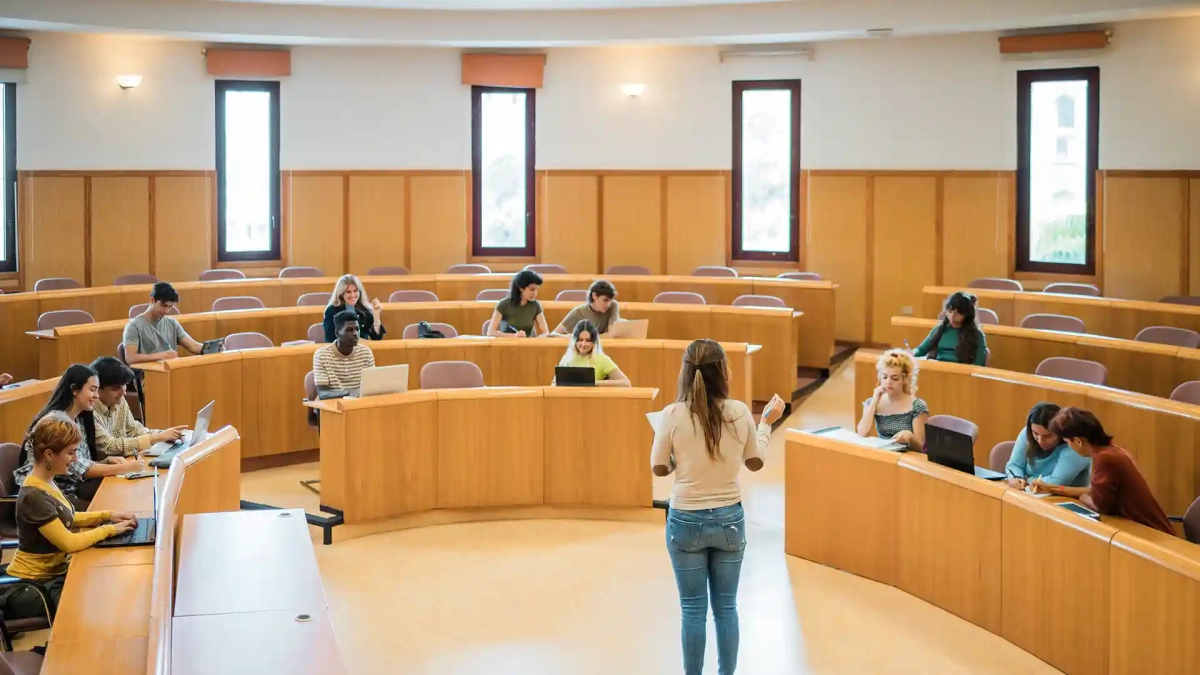DAAD Scholarships for International Students:A a Game-Changer Opportunity
- DAAD Scholarships for International Students:A a Game-Changer Opportunity
- What Is a DAAD Scholarship?
- Who Can Apply for a DAAD Scholarship?
- Types of DAAD Scholarships
- What Does a DAAD Scholarship Cover?
- How to Apply for a DAAD Scholarship
- DAAD Language Requirements for International Applicants
- When to Apply for a DAAD Scholarship
- DAAD for Indian, African, and Latin American Students
- Tips to Win a DAAD Scholarship
- Living in Germany as a DAAD Scholar
- DAAD vs Other Scholarships in Germany
- Is a DAAD Scholarship Worth It?
DAAD Scholarships make studying in Germany affordable by covering tuition, living costs, travel, and insurance. They’re open to students from over 130 countries and support Master’s, PhD, and research programs.
More than financial aid, DAAD offers access to top universities, expert faculty, and global academic networks. It empowers students to study what matters—whether that’s climate science, public health, or engineering.
With structured, transparent application processes, DAAD is one of the world’s most trusted scholarship providers. Its programs are designed to build careers, strengthen leadership, and support development worldwide.
DAAD also funds language courses, cultural integration programs, and networking events. You don’t just study—you connect, grow, and become part of a global alumni network that opens doors long after graduation.
For students from India, Africa, Latin America, and beyond, DAAD is more than a scholarship—it’s a chance to create real impact. If you’re aiming for academic excellence without financial barriers, this is your path.
In this article, we’ll cover everything you need to know about DAAD Scholarships: who can apply, what’s included, which programs are most popular, how to apply successfully, and why DAAD stands out from other funding options.
What Is a DAAD Scholarship?
Understanding the Scope and Mission
DAAD stands for German Academic Exchange Service, and it’s a publicly funded organization that promotes international academic cooperation. DAAD scholarships are designed to support highly qualified international students, researchers, and academics in pursuing their studies or research in Germany.
Programs are available at various levels:
- Bachelor’s students (limited)
- Master’s and postgraduate students
- Doctoral candidates
- Researchers and postdocs
DAAD funds can cover tuition (where applicable), living costs, travel expenses, insurance, and even language courses. It’s more than financial aid—DAAD scholarships open doors to career-building networks, intercultural exchanges, and top-tier academic institutions.
Who Can Apply for a DAAD Scholarship?
DAAD Eligibility Criteria for International Students
DAAD scholarships are open to candidates from over 130 countries, and the eligibility requirements vary depending on the program. However, there are some general conditions:
- You must hold a Bachelor’s degree (or be in the final year of your undergraduate studies)
- Your degree must be recognized in Germany
- For most Master’s programs, your Bachelor’s degree should not be older than 6 years
- You typically need two years of relevant work experience for postgraduate scholarships (exceptions apply for recent graduates)
- You must demonstrate a strong academic record and clear motivation
- Language proficiency (German or English) is required depending on the course
DAAD has specific quotas and programs targeting different regions, so students from developing countries and underrepresented academic disciplines are strongly encouraged to apply.
Types of DAAD Scholarships
Most Popular DAAD Programs for International Students
There’s a DAAD scholarship for almost every academic stage and field. Some of the most competitive and well-known programs include:
- Development-Related Postgraduate Courses (EPOS): Targets graduates from developing countries in fields like economics, public health, engineering, and sustainability.
- Helmut Schmidt Programme (Master’s in Public Policy and Good Governance): Aimed at future leaders in politics, law, and civil society.
- DAAD Research Grants: For PhD candidates and early-career researchers conducting short- or long-term research in Germany.
- Study Scholarships – Postgraduate Studies in the Fields of Fine Art, Design, Visual Communication and Film: Supports creative talent across the globe.
- Re-invitation Programme for Former DAAD Scholarship Holders: For those who want to return to Germany for academic or research activities.
Each program has its own structure, duration, and benefits—but all of them are designed to attract and support top-tier international talent.
What Does a DAAD Scholarship Cover?
Financial Benefits of DAAD Funding
DAAD scholarships are fully funded or generously funded, depending on the program. Here’s what most scholarships include:
- Monthly stipend
- €934 for graduates
- €1,300 for doctoral candidates
- Health, accident, and personal liability insurance
- Travel allowance (in most cases)
- Full or partial tuition fees (if applicable)
- German language course (2 to 6 months, depending on the scholarship)
- Family allowance and rent subsidy (for students with children or high rent costs)
This means students can focus fully on their studies or research without financial distractions.
How to Apply for a DAAD Scholarship
Step-by-Step Guide to the DAAD Application Process
Applying for a DAAD scholarship takes preparation and attention to detail. Follow these steps to maximize your chances:
- Find a suitable program
Visit the DAAD Scholarship Database and filter options based on your level of study, country, and field. - Check the specific requirements
Each scholarship has its own criteria. Pay close attention to deadlines, required documents, and eligibility conditions. - Prepare your application documents
Commonly required materials include:- CV (usually in the Europass format)
- Motivation letter (tailored to the program)
- Academic transcripts and certificates
- Proof of work experience (if required)
- Language certificates (IELTS, TOEFL, TestDaF, etc.)
- Recommendation letters
- Research proposal (for PhD applicants)
- Create a DAAD Portal account
Some programs use the online portal, while others require hard copy submissions to local DAAD offices. - Submit your application before the deadline
Be aware that deadlines vary by program and often by country. - Await results and prepare for interviews (if applicable)
Applicants are evaluated based on academic achievements, motivation, and the relevance of their planned studies or research to their home country’s development.
DAAD Language Requirements for International Applicants
Do You Need to Speak German?
Not necessarily. Many DAAD-funded programs are available in English, especially at the Master’s and PhD levels. However:
- You may need proof of English proficiency (usually IELTS 6.5+ or TOEFL 80+)
- For German-taught programs, a B1 or B2 level is typically required (TestDaF or DSH)
Even for English-language courses, DAAD may fund a German language course before your program begins, helping you integrate better during your stay.
When to Apply for a DAAD Scholarship
Timeline and Key Dates
Most applications open around August to October for the following academic year. For example:
- Apply in October 2025 for studies starting October 2026
- Research grants and short stays have different deadlines throughout the year
Tip: Always check the specific timeline listed under each program in the DAAD database. Missing a deadline, even by a day, usually means disqualification.
DAAD for Indian, African, and Latin American Students
Targeted Programs for Key Regions
DAAD has strong regional focus areas, especially for students from:
- India and South Asia: Particularly in STEM and development studies
- Africa: Focus on public health, governance, and climate change
- Latin America: Many collaborations in environmental studies, engineering, and economics
These regions often have dedicated DAAD Information Centers, local application partners, and program quotas that increase your chance of selection.
Tips to Win a DAAD Scholarship
How to Stand Out in the Selection Process
- Tailor your motivation letter
Avoid generic content. Highlight your academic goals, future career plans, and how studying in Germany aligns with both. - Demonstrate impact
Show how you plan to use your German education to bring change to your home country or field of work. - Follow instructions precisely
Missing documents or wrong formatting can lead to automatic rejection. - Apply early
Don’t wait until the last week to submit. Aim to finish at least 2–3 weeks ahead of the deadline. - Seek feedback
Have professors or past DAAD recipients review your materials before submission.
Living in Germany as a DAAD Scholar
What to Expect as a Funded International Student
As a DAAD scholar, you are not just a student—you’re part of a prestigious academic community. You’ll gain:
- Access to DAAD alumni networks
- Invitations to academic and cultural events
- Priority housing options in student dorms
- Free or discounted entry to museums, theaters, and public transport
Germany is student-friendly and internationally minded. Cities like Berlin, Munich, and Heidelberg offer a mix of academic excellence and high quality of life. Even smaller cities have excellent universities and vibrant communities.
DAAD vs Other Scholarships in Germany
Is DAAD the Best Scholarship Option?
DAAD is undoubtedly the most recognized and widely accessible scholarship for international students in Germany—but it’s not the only route to funding your studies.
- Deutschlandstipendium is a merit-based scholarship offered directly by individual universities. It awards €300 per month for high-achieving students, and funding is shared between private sponsors and the federal government. It’s ideal for students already enrolled or admitted to a German university.
- Erasmus+ is mainly for students already studying at a European institution who want to complete part of their degree in Germany. It offers mobility grants for a semester or year abroad but doesn’t fund full degree programs.
- Political foundations like Konrad-Adenauer-Stiftung, Heinrich Böll, and Friedrich Ebert Stiftung provide scholarships based on both academic merit and alignment with specific values—such as democracy, sustainability, or social justice. These are highly competitive and often require proof of social engagement or political commitment.
- University-specific grants vary widely but can include tuition fee waivers, travel allowances, or partial stipends. These are usually targeted at specific faculties or research fields and may not be widely advertised.
While these alternatives can offer substantial support, DAAD remains the most structured, inclusive, and internationally known scholarship provider, especially for students from outside the EU looking to complete an entire degree in Germany. Its global reach, clear application system, and wide range of programs make it the top choice for most non-EU applicants.
Is a DAAD Scholarship Worth It?
Absolutely! For international students who want to study in Germany without financial stress, a DAAD scholarship is one of the best paths forward. It offers generous funding, access to top universities, and a strong alumni network. Whether you’re aiming to study sustainable development in Bonn, public health in Berlin, or robotics in Munich—DAAD can make it possible.
But like all prestigious programs, it’s competitive. Preparation, attention to detail, and genuine motivation are key. If you bring those, you’ll have more than just a chance—you’ll have an edge.
How informative was this article?
Click on a star to rate it!
We are sorry that this post was not useful for you!
Let us improve this post!
What is missing in the article?















